SNARED AND DROWNED
Are fishing nets killing off a new generation of monk seals in Turkey’s protected areas?
Ozan Veryeri, Harun Güçlüsoy, Yalçin Savas
SAD-AFAG
Underwater Research Society – Mediterranean Seal Research Group
The Mediterranean monk seal, one of the rarest and most threatened mammals in Turkey, has been under legal protection since 1977. Practical conservation efforts, however, only assumed real significance in 1991 following adoption of the Turkish National Strategy for the Conservation of the Monk Seal and the formation of a National Monk Seal Committee.
A year later, local inhabitants of the Turkish Aegean town of Foça, led by the Municipality and guided by the Mediterranean Seal Research Group (AFAG), established a Local Monk Seal Committee to further grassroots conservation aims. As a first step towards safeguarding monk seal habitat, Foça and its small archipelago were declared a “pilot conservation area”. Among other restrictions, purse-seiners and trawlers were banned from the area in order to encourage recovery of depleted fish stocks, and to protect the Posidonia sea grass meadows and submerged rocky shoals as monk seal feeding grounds. Continuing a tradition already thousands of years old, artisanal fishermen were permitted to continue setting their long lines and laying their stationary nets. With industrial fishing boats no longer encroaching upon the area, both local fishermen and monk seals became the beneficiaries of increasing fish stocks.
Starting in 1993, a considerable increase in monk seal sightings and cave usage were recorded during WWF-funded scientific monitoring of the area.
The first pup born in the Foça Pilot Area was discovered by AFAG team members on 13 October 1995 during regular cave checks on Hayirsiz Island, the remotest island in the archipelago. Two days old, the female pup was named “Derya”, and her mother, “Emine”. Both were seen as symbols of great hope for the future of the Foça conservation project, now more than two years old.
A dedicated monitoring effort, spearheaded by AFAG team members and carefully-chosen local volunteers, was put into force to gather information on the mother-pup relationship and the young animal’s development. Every effort was made to avoid disturbing the seal family. Conscious of the rarity of the species and the event, witnessing these hidden facets of life were a source of joy and fascination for everyone concerned.
Local artisanal fishermen, already aware of the birth, were warned that the mother might desert the pup if they either entered the cave or ventured too close.
Then, during the late morning of 23 January 1996, a fisherman hurried into the bookstore of Soner Çinar, a member of the Local Monk Seal Committee, and shouted with excitement: “There is a seal entangled in my net; it’s alive!”
Soner and a handful of other locals rushed to the scene, taking the time to alert the pilot project team leader along the way. Upon reaching the coast they found a juvenile seal in obvious distress, ensnared in a stationary net of the type typically deployed by local fishermen. There followed a desperate effort to rescue the animal, with members of the local committee, the AFAG team leader and the fisherman who owned the nets all pitching in to free her. The seal was Derya – the pup born on Hayirsiz Island.
In autumn of the same year the research team discovered another pup in one of the caves of the impressive Siren Rocks of Orak, the largest of Foça’s islands. Born on 16 October 1996, he was named “Bahtiye” in honour of Prof. Bahtiye Musaloglu who pioneered groundbreaking monk seal studies in Turkey in 1964. To the surprise of the project team, it was discovered that Bahtiye’s mother was Emine, who had given birth to Derya the previous year. A monitoring programme was again promptly implemented, with great care being taken to eliminate potential disturbance.
While he was growing, it was noticed that Bahtiye was more ‘active’ than Derya. He was using all the caves and caverns within the small bay in which he had been born, regardless of whether his mother Emine was with him or not. As with Derya’s birth a year earlier, fishermen were asked to stay out of the area to avoid disturbing mother and pup.
The sad and shocking news reached AFAG’s project office in Foça on 10 February 1997. A family, while sailing along the coast of Fener Island, noticed a dead seal lying on a pebble beach. They carried the body with them back to port and alerted officials. When AFAG’s team leader got to the harbour, he was faced with Bahtiye’s lifeless body lying on the quay.
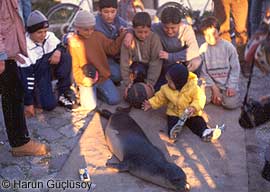
Bahtiye’s lifeless body on the Foça quay
Then on 4 December 1999, project staff encountered signs of another mother and pup while surveying habitat on the Karaburun Peninsula, adjacent to Foça on the west coast of the Gulf of Izmir. Karaburun’s importance to the monk seal, particularly the role it plays in terms of feeding and breeding movements between the two sites, has earned it provisional government acceptance as a new monk seal protected area.
The project leader at the time, Harun Güçlüsoy, and AFAG assistant Serdar Akinci, were stationed on a lookout point over a known seal cave, close to the town of Mordogan, when they heard mother-pup vocalisations. Concerned about disturbance, they refrained from entering the cave.
The same team returned to the area three weeks later to gather information about the development of the seal pup that had been named “Çevik”. Instead of observation data, however, they brought back its dead body, found washed up on a pebble beach near the cave.
Team members of SAD-AFAG’s Foça and Karaburun branch offices installed a closed-circuit, infrared-illuminated TV monitoring system in the same seal cave in November 2000. A single researcher, checking for seal presence before giving the green light to proceed, sighted a sub-adult who fled the cave as he entered. With the resident seal now temporarily absent, it was decided to install the two cameras and the infrared illuminator as quickly as possible. While the three-man team was fixing the second camera to the walls of the cave, however, they noticed a pup staring at them. Hidden in the shadows, the animal – estimated to be 7-10 days old – had escaped the attentions of the first diver sent in to reconnoitre the cave. The pup left the cave a few minutes later, while the diving crew hastily completed the camera installation.
Aided by the new system, as well as cliff-top lookout observations, a monitoring programme was started without delay. During the next three months two mature females, a sub-adult and the pup were all observed using the cave a few days every other week. When just a few weeks old, the pup – named “Melih” – was even seen in the small harbour of Mordogan, about 0.9 km south of the birth cave.
Then on 1 February 2001, SAD-AFAG’s Karaburun office received a phone call from a Gendarme officer who reported that a stranded seal had been seen a couple of kilometres south of Mordogan.
When a joint Foça and Karaburun team arrived at the scene they discovered a dead seal about 3-4 months old. The Mordogan pup Melih had last been seen 10 days earlier on the TV surveillance monitor and also from hilltop observation points. A search of the area proved fruitless. There was no sign of Melih and the Mordogan cave was deserted. The only seal to be seen occupying the cave during the following week was the subadult. There was no other choice but to conclude that the dead pup was indeed Melih.
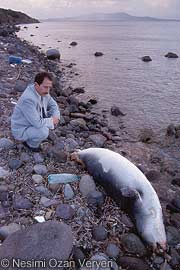
Melih's body on Karaburun
Three other cases can be added to these stories of unlucky seals. In 1991 in Foça, two years before the commencement of the pilot project, the body of a heavily decayed juvenile seal was found stranded on the mainland coast. In April 1997, turtle conservationists in Çirali, Antalya, in the south of Turkey, found the body of a 1.60m long seal stranded on the beach, some net fragments still entwined about its mouth. And, in November 2000 during the last pupping season in Bozyazi – where SAD-AFAG’s Mediterranean Programme Office is monitoring a planned monk seal protection area – a fisherman found a drowned pup with “long black fur” in his nets.
Of these six mortalities, in the four cases where necropsies were performed (Bahtiye, Çevik, Melih, and the pup found in Çirali, Antalya), deaths were all attributed to drowning. In three cases (Bahtiye, the unnamed pup from Bozyazi, and Derya, the seal successfully rescued from nets in Foça), clear documentary evidence exists that the animals were caught in stationary nets. In the case of Melih, a 5mm deep narrow depression could be distinguished on the neck of the corpse, suggesting that rope had played a role in the animal’s death. The ages of these seals were between 10/30 – 117 days when they were found entangled or stranded.
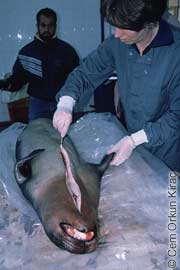
Bahtiye's necropsy
The precise locations of where the entanglements occurred are known for Derya, Bahtiye and the unnamed pup of Bozyazi. These individuals were caught 3.7 km (2.0 nm), 5 km (2.7 nm), and 6.3 km (3.4 nm) away from the caves where they were born. In the cases of Melih and Çevik, the distance between the stranding point and the known birth caves were 5 km (2.7 nm) and 0.37 km (0.2 nm). In the remaining two cases, the breeding caves were not known.
Except in two cases, all these incidents occurred on the coasts and islands of the Gulf of Izmir, one of the most important fishing grounds in Turkey and home to the largest fishing fleet in the Turkish Aegean. Along with every kind of trawler and seiner, the number of artisanal, small-scale fishing boats are much greater in this area compared to many other coastal regions of Turkey. Within the Gulf, stationary nets are set on almost every coast and only forbidden in restricted naval zones.
Only two areas within the Gulf have so far been identified as monk seal breeding habitat: the small archipelago of Foça and the cave close to Mordogan on the Karaburun Peninsula. Since juvenile seals are sighted almost every year whose birth caves are unknown, we can only assume that other breeding habitat does exist somewhere in the vicinity.
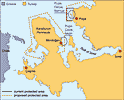
Entrapment zones in the Gulf of Izmir (click on image to enlarge)
In Foça, all the identified birth caves are situated on islands, of which the farthest is just 1.85 km (1.0 nm) away from the mainland. Since 1993, two pups born in two different caves were both caught in stationary nets. The distances of these caves to Foça’s town centre are 5.2 km (2.8 nm) and 6.5 km (3.5 nm) respectively.
The Karaburun cave near Mordogan is 0.9 km (0.5 nm) away from the town centre. Located within a small patch of undeveloped state land, the cave is engulfed by secondary housing all but deserted outside the summer holiday season. While its earlier monk seal breeding history is only known from anecdotal accounts, in 1999 and 2000 two pups were discovered by AFAG to have been born in the cave and both subsequently drowned. In contrast, around Bozyazi-Anamur on the Cilician coast, where two caves are known to be used for breeding, human population figures, coastal developments, and the number of artisanal fishermen are comparatively low. Since SAD-AFAG’s conservation efforts in the region started in 1994, ten seal pups have been born in the region and, up until November 2000, no incidental catches were recorded.
The limited data available thus suggest that, of the two areas under study, the Gulf of Izmir poses a far greater threat to monk seal pup survivability in terms of entanglement than the Bozyazi–Anamur coast in the Cilician Basin. According to the evidence collected so far, of 4 pups born in the Gulf of Izmir since 1993, all have been entangled in nets and only one has survived (Derya); in the Cilician study area, on the other hand, 8 out of 10 have survived and only one of these mortalities was due to entanglement. In other words, the entanglement ratio for the Gulf of Izmir is 4/4 with a single survival, while it is only 1/10 on the Cilician Coasts.
The sharp contrast between the two areas appears to be entirely due to fishing pressure and the design of core zone restrictions in protected areas. In the Bozyazi–Anamur area, for example, quite apart from the relatively low intensity of artisanal fishing generally, one of the two breeding caves in question is situated within a no-fishing zone. Although a pup born here became an entanglement victim last year, the animal drowned in nets away from the restricted area.
In the Gulf of Izmir there are no such restrictions around known monk seal breeding caves, even within the stipulated ‘core zone’ of the Foça Specially Protected Area where all human activities are prohibited except for artisanal fishing. Indeed, local artisanal fishermen can often be seen laying their nets within only a few metres of inhabited caves.
While these fishermen remain key, long-term partners in the conservation process, it is impossible to ignore the fact that, in the Gulf of Izmir at least, the incidental entrapment and drowning of pups and juveniles up to 4 months old in stationary nets is seriously jeopardising the survival and recovery of the species in the region.
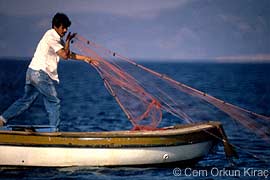
Artisanal fisherman in Foça
The question is, what can be done to give these newborn pups every possible chance of survival? The simplest and most effective answer is to declare core zones around known breeding caves, and to ban the laying of stationary nets for at least four or five months during each breeding season, commencing every October or November.
Taking into account the entanglement locations and the proximity of identified breeding caves, it is also reasonable to extend that proposed ban to cover a wider area of the Foça archipelago, effectively extending the current ~5.5 x 3 nm protected area by some 2-3 nm on a seasonal basis. In the case of Karaburun, a stretch of coast about 15 km long, with the Mordogan cave at its mid point, could seasonally be put off limits to fishing with stationary nets.
While logic alone dictates this course of action, one cannot underestimate the potential hurdles in enforcing such restrictions, particularly since Foça is one of the largest fishing harbours in the Turkish Aegean. About 40 artisanal boats, 5-8 metres in size, crewed by 1-2 fishermen using stationary nets, long-lines, lines and baskets, mostly operate around Foça’s off-lying islands, within a limited area of around 6 x 2 nautical miles. Although no firm figures are available, it is likely that about 60 families either fully or partially depend on this local industry. Most of the fishermen use stationary nets, some alternate between nets and long-lines depending on the season and the fish species targeted, while the remainder prefer to use only long-lines and lines. Conditions around the Mordogan breeding cave on the west coast are similar, although the numbers of boats and fishermen are virtually half those found in Foça. These boats generally fan out along the coast from north to south, fishing in the 3 nm-wide shallow channel between the mainland and Uzun (Long) Island. Both Foça and Mordogan have their own fishing cooperative that collaborates with SAD-AFAG to prevent illegal fishing and to generally promote sustainable use of fish stocks.
Despite these advances, most artisanal fishermen jealously guard their traditions and are suspicious of regulation – except where it affects their foes, the trawler-men. They also show strong conservative streaks when it comes to their own fishing techniques, which they are reluctant to change or modify. Most view local fishing grounds as their own personal property. Many are poorly educated and remain on the lower rungs of both the social and income ladder. For the most part, they support monk seal conservation only because the conservationists have been prepared to listen to their problems and to carry their message to the higher reaches of government. In the case of Foça, they have succeed in having the trawlers, coastal seiners and purse seiners banished as the price of their commitment to the conservation process. Hearing of fish stock recovery in the area, fishermen from adjacent towns are now eagerly seeking the same advantages.
In view of these stark realities, who will be brave enough to enter the lion’s den and ask the fishermen to stop laying their nets during the most profitable season – scientists, conservationists, politicians?
Without offering anything in exchange – direct compensation, an alternative fishing technique or income source, special re-training programmes – the end result could well be more threatening for the seals than the nets themselves.
Some have even raised the possibility of removing pups from their mothers and raising them in special rehabilitation units until they reach 4-5 months and can more safely fend for themselves. Such drastic action is, however, fraught with difficulties, both from an ethical and operational point of view.
The entanglement threat is due to be discussed during the next meeting of the National Monk Seal Committee in a few months’ time, along with procedural matters governing the creation of monk seal protection areas. The options are few, but the risks great. Despite significant progress on the monk seal conservation front in many key areas, we cannot escape the fact that entanglement in certain areas is killing off a new generation of monk seal pups.
And to save the next probable victim, we have just six months.
Further reading on monk seal entanglement
Johnson, W.M. & A.A. Karamanlidis. 2000. When fishermen save seals. The Monachus Guardian 3(1): May 2000.
Androukaki, J. 2000. Letters to the editor. When fishermen save seals. The Monachus Guardian 3(2): November 2000.
|



